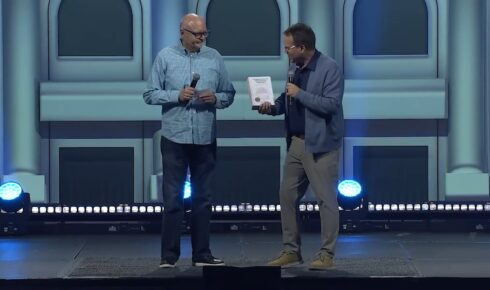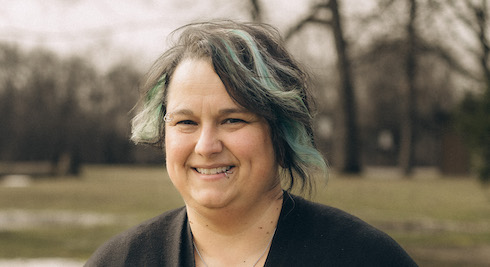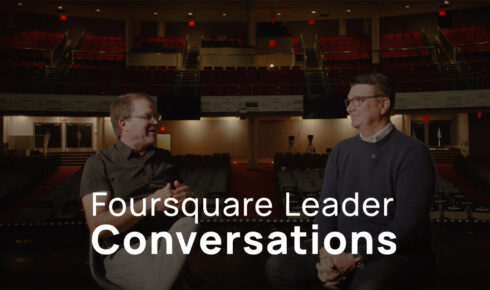
Editor’s Note: As Foursquare Connection 2024 heads to National Harbor, Md., May 27-30, 2024, we look back at when Foursquare founder Sister Aimee Semple McPherson held a revival in nearby Washington, D.C., in 1920.
Crowds lined the street hours before the church service began. A police presence was necessary to maintain control of the excited throng of people. When the doors were opened, the 1,000-seat sanctuary quickly filled to capacity, as did the overflow room in the lower level of the church. To avoid the crush of the crowds, the pastor and evangelist had to slip into the service from behind the auditorium, climbing through a window.
The year was 1920; the place was McKendree Methodist Episcopal Church in Washington, D.C. The pastor was Charles A. Shreve; the evangelist was Aimee Semple McPherson. This revival had a dynamic impact in Washington, D.C., one that lasted for many years.
Sister Aimee proclaimed a simple message of repentance and faith in Jesus Christ. When the invitation was given, crowds packed the altar—penitents weeping as salvation flowed, the sick seeking prayer for healing, souls hungry for more of God were prostrate on the floor under the power of the Holy Spirit.
“I cannot perform miracles. I can only help you to get faith in the Lord. It is He who can heal you. As Jesus healed the multitudes while He was on Earth, so He can and will heal those who place faith in Him.” —Aimee Semple McPherson, during 1920 Washington, D.C., revival
The three-week revival campaign began at McKendree on Sunday, March 21, 1920. From the first day of the revival, it was evident that the blessing of God was upon those meetings. Pastor Shreve recalled multitudes of people “came seeking God” and “stampeded . . . to the altar.” At every service the altar “was crowded again and again with earnest seekers after God,” and by the close of the revival, “about three hundred persons” had been converted to Christ.
The church was “stormed by the people,” which required a police presence to manage crowd control. It was standing room only in the sanctuary, and a downstairs overflow room was also filled to capacity. On some occasions, hundreds were turned away. Crowds of people stood for hours outside the church parsonage, hoping to get a glimpse of Sister Aimee.
In the second week of services, Sister Aimee conducted an afternoon prayer meeting for the healing of the sick on Thursday, April 1. The Washington Times reported more than 100 persons attended. “Some were carried in, others came on crutches, still others blind, were led to the church.” According to all reports, several women were cured out of sickness, a woman with rheumatic arms had regained the use of her limbs, a 6-year-old girl recovered from failing eyesight, a woman who had been confined to her bed for three months gradually became well, and a man paralyzed on his left side noted an improvement in his condition.
On April 8, another healing service was conducted at McKendree. Twelve hundred persons packed the church; Sister Aimee preached a message of faith in Jesus to heal. “I cannot perform miracles,” she said. “I can only help you to get faith in the Lord. It is He who can heal you. As Jesus healed the multitudes while He was on Earth, so He can and will heal those who place faith in Him. Let us bow our heads and pray to Him.”
The healing service lasted for five hours. Sister Aimee briefly spoke with each supplicant, anointed them with oil and prayed over each one. Many persons were healed that day; their names, addresses, ages and descriptions of their physical conditions were reported in the paper.
Several persons were healed of paralysis. One example: 12-year-old Nicholas Berezoski had been “stricken with infantile paralysis” as a 2-year-old. Consequently, he wore a leg brace to walk. “In the name of Jesus, you shall be healed,” Sister Aimee declared. She removed the boy’s brace. He ventured forward. And, unassisted, his hands at his side, standing upright, the lad walked.
Mrs. Fannie Wallace had been paralyzed on her “entire left side” for 15 years, leaving her “little use of either her hand or leg.” After being anointed and prayed for, Mrs. Wallace began to walk, with some hesitation. “Then she hurried, and then she danced. ‘Praise the Lord, praise the Lord,’ she cried out, and for more than two minutes she danced and waved her hands in the air.” Mrs. Wallace was 67 years of age.
The next day, The Washington Times reported that many sick and afflicted persons were unable to attend the revival meetings, so Sister Aimee encouraged them to send her handkerchiefs, which she anointed and prayed over. These pieces of cloth were then placed upon the afflicted areas of the body. More than 100 handkerchiefs had been received and prayed over.
More than 3,000 sick and infirm persons were prayed for during the revival. The McPherson revival at McKendree concluded on Sunday, April 11, 1920. More than 50,000 persons had attended the services; about 300 persons were converted to Christ, many Christians experienced “a real, Pentecostal baptism of the Holy Spirit,” and many claimed to experience “complete healings.”
The revival fires, ignited by Sister Aimee, did not wane following her departure from McKendree. Throughout 1920, the revival spirit continued to burn. Crowds continued to fill the church on Sundays, with conversions taking place in almost every Sunday evening service. Pastor Shreve instituted a healing service on Tuesday afternoons. “The power of the Lord was invariably present in mighty manifestation,” he said, and “large numbers of people [were] healed of various complaints and diseases.”
Editor’s Note: Sister Aimee went back to Washington, D. C., in 1927 to hold another revival. As reported in The Bridal Call Foursquare (March 1927): “Then came a telegram from the management of the Washington Auditorium, inviting Sister McPherson to speak in that magnificent edifice. … With 7,000 inside and 5,000 outside, listening by loudspeaker, Washington, D.C., ‘the heart of America,’ received the glad news from ‘the lips of her whose greatest joy in life’ is to speak the sacred name of Jesus.”
This article is adapted with permission from a paper titled “Lord, Go Among Us”: Charles A. Shreve and the Pentecostal Revival at McKendree Methodist Episcopal Church, Washington, D.C., copyright 2019, by P. Douglas Chapman. You can read the paper here.


